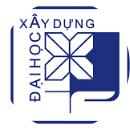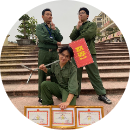. Read the passage, then choose the letter A, B or C to answer these following questions. (Đọc đoạn văn rồi chọn đáp án A, B, C hay D để trả lời câu hỏi)
A. Tet or Lunar New Year is the most important holiday in Vietnam. It generally takes place around late January or early February. Tet holiday is considered the best occasion for family members to get together. During Tet, Vietnamese spend time shopping for the New Year, go to pagodas and temples. The items of shopping range from food to clothing to household decorations. People often make Banh Chung, the main food for Tet holiday and other special foods. The Vietnamese believe that Tet Holiday is an occasion to enjoy life after a full hard-working year.
Câu 55. When does Tet happen?
A. On January. C. Early February.
B. Around late January. D. Around late January or early February.
Câu 56. What is the other name of Tet?
A. New Year. C. Lunar Year.
B. Lunar. D. Lunar New Year.
Câu 57: What do people do during Tet?
A. Travelling around the world.
B. Going to Pagodas and temples.
C. Making special food, decorate houses, shopping and go to the pagodas.
D. Shopping for the New Year.
Câu 58. What food do people often make on Tet?
A. Banh Chung. B. Special food.
C. Rice. D. Banh Chung and Special food.
Câu 59: Is Tet the most important holiday in Viet Nam?
A. Yes, it is. C. Yes, it isn’t.
B. No, it is. D. No, it isn’t.
Câu 60. Who gets together on Tet holiday ?
A. Club members. C. Family members.
B. People. D. Nobody.
Câu 61: What do The Vietnamese believe?
A. It’s an occasion for people to relax.
B. It’s an occasion for people to enjoy life after a full hard-working year.
C. It’s an occasion to get together.
D. It’s an occasion for people cook meals.
Câu 62. Do Vietnamese go shopping for the New Year?
A. Yes, they do. B. Yes, they does. C. No, they don’t. D. No, they does.
B. Da Nang has a population of nearly 800,000 people. The Han River flows through the city. There are five bridges across the river. The Han River Bridge is the newest one now.
The cost of living in Da Nang is the lowest in Central Viet Nam. Da Nang has many beaches. Among them, Non Nuoc Beach is one of the most beautiful beaches in the world. But walking in the streets on a summer afternoon is not a good idea in Da Nang. There are not many trees so there are not many shadows. It is often very hot at noon.
Câu 63. The population of Da Nang is …………
A. over 800,000 B. mostly 800,000
B. C. more than 800,000 D. 800,000
Câu 64. The Han River Bridge is…………
A. the newest B. the newer
B. C. newest D. newer
Câu 65. The most beautiful beach in Da Nang is………….
A. Han River B. Ha River Bridge
C. Central Viet Nam D. Non Nuoc
Câu 66. There are not lots of ………..
A. flowers B. streets
C. trees D. bridges



























